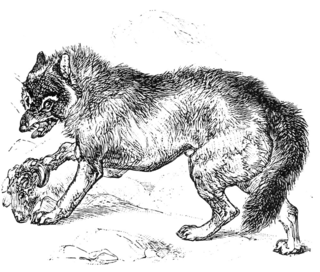Genetics
Of Glaciers, Wolves, and Humans
A new study calls northeast Siberia the birthplace of dogs.
Posted January 31, 2021

I was greeted the other morning by an email from a friend telling me that a paper published that day in the Proceedings of the National Academy of Sciences (PNAS) confirmed an idea I first put forth in How the Dog Became the Dog: That the Last Glacial Maximum served as a pivotal period in development of a distinctive dog morphology that distinguished them from wolves. During that time, animals and plants took refuge in areas that were shielded from the bitter cold. My theory was that if you could find refugia where wolves and humans were in close proximity during this period, you might find out where the animals we recognize today as dogs emerged. Further, I suggested that after the ice began to retreat from its maximum extent, humans and their dogs took to the trail.
Angela Perri, a zooarchaeologist at the University of Durham, England, writing for six colleagues from a number of institutions, identifies northeast Siberia as this area. Roughly 23,000 years ago, they say, a refugia there supported herds of large ungulates, the plants they grazed on, and the carnivores who hunted them, including wolves and humans. She presents the case that as the ice melted and ice-free corridors began to open up in the Americas, which, it is believed, were unpeopled, humans and their dogs pushed into that new terrain and rapidly dispersed starting around 15,000 years ago. Other humans and dogs dispersed to the west, but their story is not the one Perri and her colleagues tell. The research team provides extensive analyses of genetic materials from ancient dogs and humans, which it then compares with available physical evidence of humans and dogs throughout the New World.
This paper provides hard-core genetic data from early dog remains found in the Americas, associated with remains of humans, and so strengthens the case that when people came into the New World, they came with dogs. The data is compelling, but the overarching idea put forward by the authors is hardly new. I posited in 2011 that the Last Glacial Maximum was a pivotal point in the evolution of the dog precisely because it was when the distinctive dog morphology was set genetically. At the time, I also explained in detail that I was employing evidence available from archaeologists, geneticists, and paleogeographers. My goal was to identify a time and place where there were people and wolves in sufficient numbers to form an enduring alliance together, since you cannot have a wolf domesticated by no one. I identified several refugia as possible areas where this might have occurred. These included probable mixing zones where people would gather for trade. Whether domestication occurred in one place or more—and it could easily be more because domestication is, finally, a cultural as well as a biological event—the practice of living with wolves was passed on from generation to generation and allowed for the continuity of the relationship more than the genes did.
I also suggested, as I have many times since, that there is tantalizing but not abundant evidence that the association between wolves and hominins—our ancestors—has been going on for hundreds of thousands of years.
I say that knowing it is sure to be controversial or dismissed out of hand, but I would note that new discoveries in anthropology and evolutionary genetics have consistently served to push back critical dates in human development—for example, fire making, speech, art, music, and domestication of the wolf.
It is true that ideas cannot be copyrighted; however, if an idea or way of looking at a question is new, the person who advances it should be cited. It is not only ethical, but a form of intellectual courtesy. I am disappointed that, despite the fact that I have communicated with at least two of the authors of this paper in the past—I even shared a spot on NPR’s Science Friday with one of them a decade ago—they fail to do me that courtesy or recognize that much of what they put forward uses the same methodological approach I helped pioneer, of putting dogs and people in the same place at the same time. Nor do they acknowledge that the argument they make parallels ideas that I advanced years ago; indeed Perri said it was a "new hypothesis," when speaking to a New York Times reporter and another author told the reporter the impetus for the hypothesis came from a “brainstorming session” over a blank whiteboard that rapidly filled with their ideas. This is, from my perspective, either disingenuous or a sign of deficient knowledge of the previous literature.


